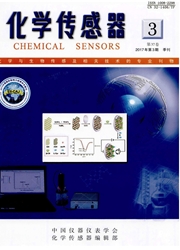

 中文摘要:
中文摘要:
发展了一种基于"树枝状"信号放大的电化学生物传感器用于DNA的检测。该传感器利用两种DNA功能化的纳米金颗粒,通过两次"三明治"杂交,在电极表面形成"树枝"状结构,从而实现DNA的定量检测。首先通过共价交联方法获得巯基DNA1和DNA2修饰的两种纳米金颗粒,其中DNA1和DNA2与目标cDNA部分互补。然后,修饰在金电极上的捕获探针DNA1与目标cDNA分子及巯基DNA2修饰的纳米金颗粒(DNA2-AuNPs)形成第一个"三明治"杂交结构,实现一次放大检测。接着,DNA2-AuNPs又可与cDNA、巯基DNA1修饰的纳米金颗粒(DNA1-AuNPs)形成第二个"三明治"杂交结构,实现二次放大检测。这种"树枝状"放大信号的方法的检测限是0.13pmol/L,相对仅利用纳米金颗粒放大的方法而言,其检测限降低了4倍。并且,该传感器具有较好的识别碱基错配的能力。
 英文摘要:
英文摘要:
We herein developed a dendritic signal amplification biosensor for DNA detection. It relied on the use of two different DNA functionalized gold particles, which could be self-assembled to build sandwich-type dendritic architectures. The two different gold particles were modified by DNA1 or DNA2, DNA1 and DNA2 were partly matched with cDNA. The first "sandwich" involved capture probe DNA1 immobilized on gold electrodes and DNA2 labeled with gold nanoparticles that flank the target eDNA sequence. The dendritic amplification was based on the second "sandwich", which DNA2 labeled with gold nanoparticles and DNA1 labeled with gold nanoparticles that flank the target eDNA sequence. The detection limit was 0.13 pmol/L. The strategy has improved the detection limit for nearly 4 times compared to "gold nanoparticle-only" method. In addition, the sensor exhibited excellent selectivity against single-base mutation discrimination.
 同期刊论文项目
同期刊论文项目
 同项目期刊论文
同项目期刊论文
 Atomic force microscopy investigation of the characteristic effects of silver ions on Escherichia co
Atomic force microscopy investigation of the characteristic effects of silver ions on Escherichia co Noninvasive monitoring of intracellular pH change induced by drug stimulation using silica nanoparti
Noninvasive monitoring of intracellular pH change induced by drug stimulation using silica nanoparti Sensitive fluorescence detection of nucleic acids based on isothermal circular strand-displacement p
Sensitive fluorescence detection of nucleic acids based on isothermal circular strand-displacement p Activatable aptamer probe for contrast-enhanced in vivo cancer imaging based on cell membrane
protei
Activatable aptamer probe for contrast-enhanced in vivo cancer imaging based on cell membrane
protei Pyrene-Excimer Probes Based on the Hybridization Chain Reaction
for the Detection of Nucleic Acids i
Pyrene-Excimer Probes Based on the Hybridization Chain Reaction
for the Detection of Nucleic Acids i Electrochemical Detection of Thrombin Based on Aptamer and Ferrocenylhexanethiol Loaded Silica
Nanoc
Electrochemical Detection of Thrombin Based on Aptamer and Ferrocenylhexanethiol Loaded Silica
Nanoc On-chip oligonucleotide ligation assay using one-dimensional microfluidic beads array for the detect
On-chip oligonucleotide ligation assay using one-dimensional microfluidic beads array for the detect Telomerase catalyzed fluorescent probes for sensitive protein profiling based on one-dimensional mic
Telomerase catalyzed fluorescent probes for sensitive protein profiling based on one-dimensional mic Rhodamine B isothiocyanate doped silica-coated fluorescent nanoparticles (RBITC-DSFNPs)–based biopro
Rhodamine B isothiocyanate doped silica-coated fluorescent nanoparticles (RBITC-DSFNPs)–based biopro Preparation of luminescent Cy5 doped core-shell SFNPs and its application as a near-infrared fluores
Preparation of luminescent Cy5 doped core-shell SFNPs and its application as a near-infrared fluores Identification of liver cancer cells in a mixed cell system using galactose-conjugated fluorescent n
Identification of liver cancer cells in a mixed cell system using galactose-conjugated fluorescent n Electrochemical detection of nicotinamide adenine dinucleotide based on molecular beacon-like DNA an
Electrochemical detection of nicotinamide adenine dinucleotide based on molecular beacon-like DNA an Electrochemical biosensors for detection of point mutation based on surface ligation reaction and ol
Electrochemical biosensors for detection of point mutation based on surface ligation reaction and ol Barbated Skullcup herb extract-mediated biosynthesis of gold nano-particles andits primary applicati
Barbated Skullcup herb extract-mediated biosynthesis of gold nano-particles andits primary applicati Fluorescent Nanoparticle-Based Indirect Immunofluorescence Microscopy for Detection of Mycobacterium
Fluorescent Nanoparticle-Based Indirect Immunofluorescence Microscopy for Detection of Mycobacterium A novel molecular beacon based bioassay for highly sensitive and selective detection of NAD+ and the
A novel molecular beacon based bioassay for highly sensitive and selective detection of NAD+ and the Chemical etching with tetrafluoroborate: a facile method for resizing of CdTe nanocrystals under mil
Chemical etching with tetrafluoroborate: a facile method for resizing of CdTe nanocrystals under mil 期刊信息
期刊信息
